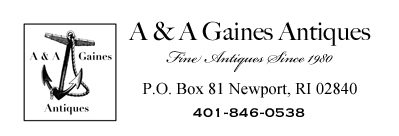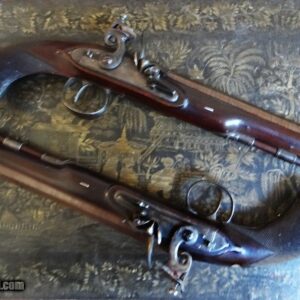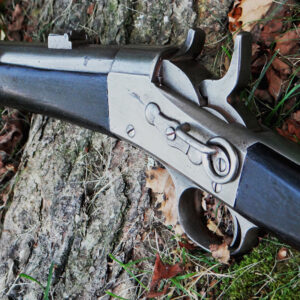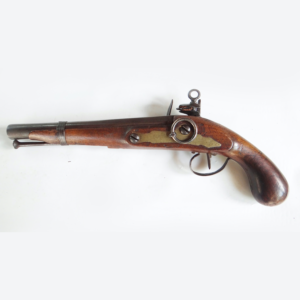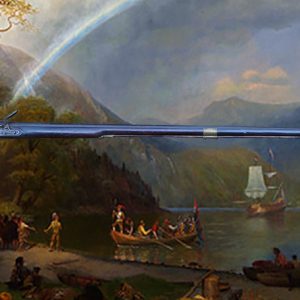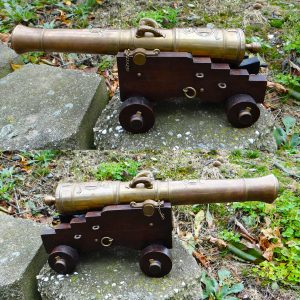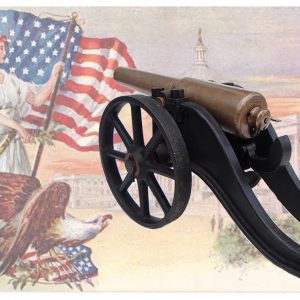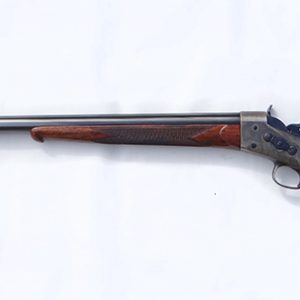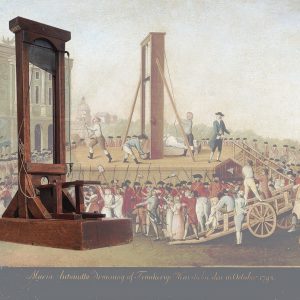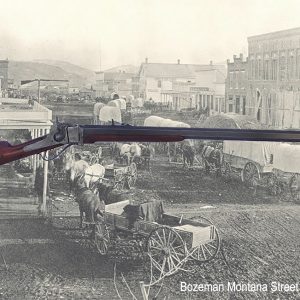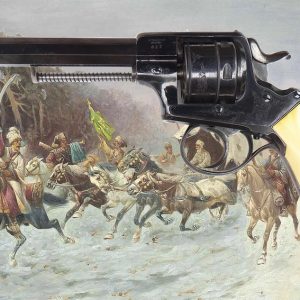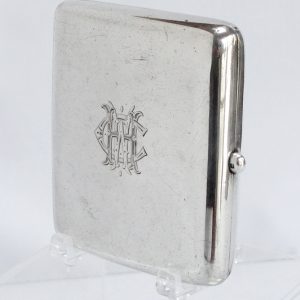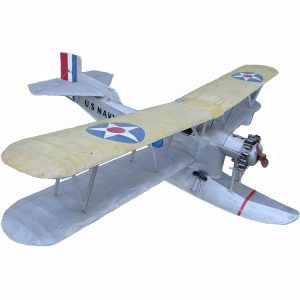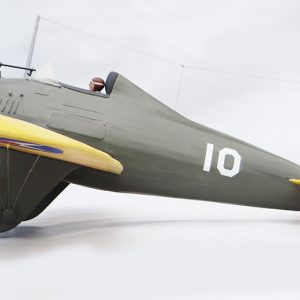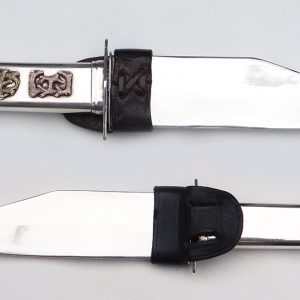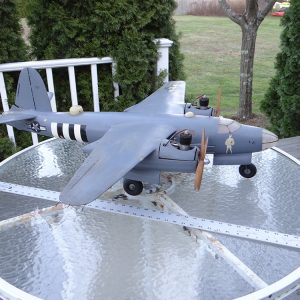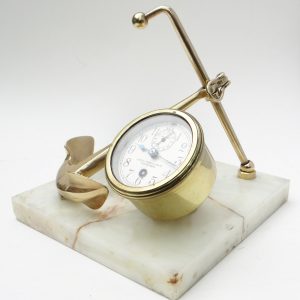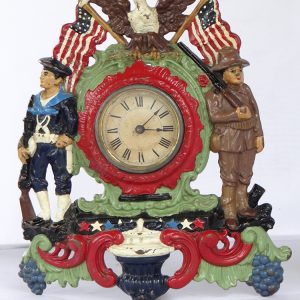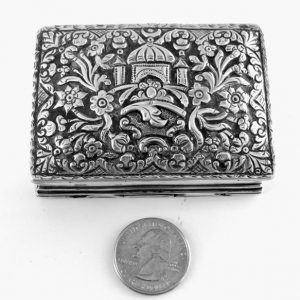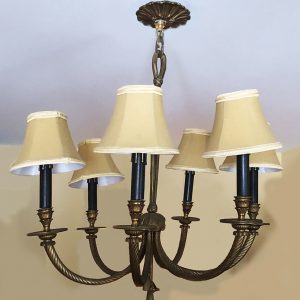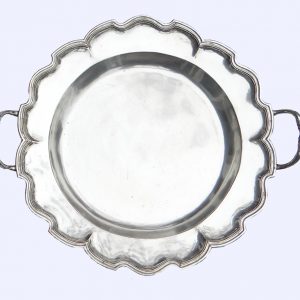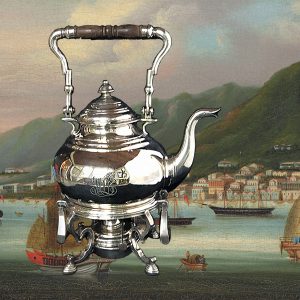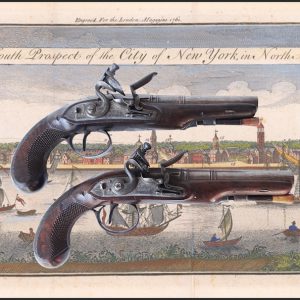An excellent original pair of British flint lock officer’s pistols with a very special feature – THEY ARE .80 CALIBER ( 9 bore/gauge) and were built for a member of the British Nobility. The silver wrist escutcheons on each of these truly rare, possibly unique, pistols bears a Ducal Coronet featuring a shore bird ( crane, swan, stork, egret, etc.) which appears to be eating a frog. The pistols were produced by ‘G. Goodwin & Co., London, 1807-1818, whose factory was in Birmingham. They are high quality officer’s pistols in the style popular at that time with full stocks, 8” barrels, and steel mountings. Goodwin & Company was associated with the British Ordnance Department producing flint lock pistols and guns. They were also suppliers of gun flints and are well listed in arms makers books.
Upon examining such an unusual pair of pistols one has to wonder why a British Duke would have them built to his order. The term ‘Howdah Pistols’ may have been coined in the 19th century or is possibly a more recent collector’s label for handguns, both muzzle loading and breech loading, of exceptionally large bore. Pistols of this genre were intended as an emergency defensive weapon when hunting tigers and other big cats in India and the great majority were built during the Victorian era. Sahibs and Maharajas hunted tigers while riding in ‘Howdahs’ strapped upon the backs of elephants, retainers would drive the tiger to them. Sometimes a Sahib would wound a tiger who would then turn about in a rage and climb the side of the elephant to get at his/her tormentor. In these situations the hunter would try to save himself by firing the most powerful pistol he could hold into the tiger before it could bite his head off. The heyday of the ‘Howdah Pistol’ occurred during the percussion and early cartridge period – 1835-1910 – corresponding with the increase of British presence for business and/or pleasure on the Indian subcontinent.
Flintlock examples of ‘Howdah Pistols’ are true rarities. Large and dangerous game hunting during the flintlock period in the wild regions of North America and India would have been limited to British East India Company people who might unexpectedly meet tigers, etc. and Hudson’s Bay Company personnel operating in the Rocky Mountains and Northwest who might confront grizzly bears and their like (African safaris would be a thing of the future). In reality not many in either trading company would have had the need for a handgun which upon firing would be pretty punishing at both ends. However it is well known that both the British East India and Hudson’s Bay Companies appointed executives and sought patronage from the ranks of British nobility while members of the nobility sought adventure and added prestige from association with those organizations. It is expected a British Duke heading to the wilds of North America or jungles of India – having some knowledge of where he was going – would commission a pair of the most powerful pistols he could imagine and not be adverse to putting himself in a spot where he might need them.
This handsome pair of mega-pistols though in excellent condition do show signs of real use showing some shooting wear on their frizzens and light erosion in their priming pans. The locks are engraved ‘G.GOODWIN & Co.”, snd the barrels are engraved “LONDON”. Their twist-iron barrels retain over 90% period brown finish with some slight fading. The touch holes have platinum bushings and the breeches have platinum bands.The locks retain most of their faded casehardening with excellent function. The steel hardware retains over 90% fire blued finish with some light aging. The fine walnut stocks are excellent with sharp checkering and contours and retain nearly all their original surface and finish with some light handling marks. The pistols retain their original ramrods, one with ‘worm’, the other with threaded end for cleaning attachments. These pistols have been very well cared for during their period of use and thereafter.
This rare and most impressive pair of pistols must have a very interesting history. Given the original owner’s Ducal Coronet atop the pistol’s wrists and knowledge the pistols were built between 1807 and 1817 it should be very possible for one skilled in the study of British heraldry to identify who carried these pistols….or for a collector to get help in this. This excellent and intriguing pair of pistols, found in an American estate, and new to the collector’s market, would stand out in a private or public collection.
Dimensions: overall length 13 1/2”, barrels 8”, bores .80 caliber – 9 gauge
Antique: Yes
Manufacturer: G. Goodwin & Company
Barrel Length: 8
Condition: excellent
Metal Condition: excellent
Wood Condition: excellent
Manufacture Date: 1807 – 1817
A very rare .50 caliber Remington Rolling Block saddle ring carbine designed for Mexican President Porfirio Diaz special ‘RURALE’ police force. When Diaz became president of Mexico in 1876 he reconstituted a special force of mounted police to ‘maintain order’ in Mexico’s northern states and along the American Southwest border. One thousand Remington rolling block saddle ring carbines were specially ordered for this force, it is believed they were delivered to the port of Vera Cruz in 1877. The carbines were built on Remington’s No.1 military action in .50-70 US caliber with 20 1/2” barrels. In addition to saddle rings these carbines also had standard sling swivels fitted on their left sides. These carbines were ordered with an interesting special feature, their firing plans were specially designed such that they could fire both the standard .50-70 US centerfire cartridge AND .50 caliber Spencer repeating rim fire rifle cartridges. The Mexican government had purchased a quantity of US surplus Spencer carbines and ammunition and since the ‘Rurales’ patrolled the remote ‘Frontier’ it was thought a good idea they could use both types of ammunition in their carbines’. These thousand ‘Rurale’ carbines were the only military rolling blocks Remington built with this feature.
The ‘Rurales’ were intended to preform similar duties to the Texas Rangers on the US side of the border. They were also in a constant state off war with Apache, Lipan, and Yaqui Indians. They also had to deal with all manner of Mexican bandits, Diaz’s political enemies, and American cattle and horse rustlers. The growth of American ranching in Arizona, New Mexico, and Texas along with the founding of towns like Tombstone, AZ led to a high demand for cattler and horses beyond what the local ranchers could provide. American ranchers and cowboys found it very profitable to cross into Mexico late at night to steal cattle and horses from Mexican rancheros which led to cross-border reprisals, ambushes, by both ‘Rurales’ and Americans. In one instance in the Fall of 1881 Americans attacked Mexican gold smugglers crossing into the US. It is believed a ‘Rurale’ officer was with the smugglers and survived to lead an ambush of American cattle rustlers in which the patriarch of the Clenton family was killed, which may have hastened the gunfight between Clantons and Earps at the ‘OK Corral. In any event the ‘Rurales’ themselves came to be regarded as dangerous criminals by Mexicans and Americans on both sides of the border.
Very very few of the special Remington Rolling Block carbines issued to the ‘Rurales’ in 1877 survived their hard usage. The few known specimens in collections are for the most part in deplorable condition. Over the last fifty plus years this is the only ‘Rurale’ carbine I have ever had in hand and it is a very presentable survivor. Included with the overall and detail pictures of this carbine is a period photograph of Mexican ‘Rurales’ shouldering their carbines, it is the best period picture I could find showing the carbines and from it one can deduce they were originally finished in-the-white (natural steel finish) which was a traditional finish for military firearms of the period.
The exterior surfaces of this carbine are fine with good Mexican government marks and Remington factory markings. Edges and contours are crisp. There is evident aging and all surfaces have a pleasing natural steel patina. Mechanical functions are excellent. The bore shows considerable use retaining clear rifling and pitting – not as worn as one would expect given where it’s been. The original walnut butt stock and forearm are fine retaining good color and old finish.
Given the small number of these carbines built and their hard use over a long period it is amazing this one has survived in a condition fit for a fine collection of Remington and/or Frontier firearms. This is probably one of the best of the few known ‘Rurale’ contract Remington carbines.
Dimensions; overall length 36”, barrel 2o 1/2”, caliber .50-70 US cf / .50 Spencer rf
Price: $1,975.00
A Spanish Colonial a flintlock ‘Cavalry pistol’ of the 1803 – 1812 period featuring a very rare type of flintlock with both half and full cock notches on both the tumbler and edge of cock. This is the exact pistol pictured and described in “Spanish Colonial Weapons in Colonial America 1700-1821,” by S. Brinkerhoff & P. A. Chamberlain, Stackpole Books, 1972, page 5-54, pate 83 & 84 (see photos below).This is a large and imposing military pistol, 15” long with 9” barrel. It is .69 caliber.
Most Spanish pistols from the 17th century on were built with substantial belt hooks on the the left sides of the stock opposite the lock. This pistol has a large saddle ring instead indicating it was to be carried in the manner of a carbine – attached to an over the shoulder ‘carbine sling’ which was the standard way for mounted troops to carry their carbines from the early 18th cent. into the early 20th cent.
In the first decade of the 19th century some officers of mounted troops thought the usual pistol caliber for cavalry – .54 to .62 – was not powerful enough and they decided to equip some mounted troops with .69 caliber ‘horse pistols’ which was full musket bore in the US, France, and other countries. The British introduced a .69 caliber Heavy Dragoon Pistol jn 1796 and the US Springfield Arsenal built some .69 caliber model 1817 pistols in 1817-1818. It was thought these big pistols with a full musket/carbine load – either a single ball, or buck & ball load would better serve in mounted battles. In any event troops issued these ‘magnum’ pistols didn’t like them at all – too much recoil and too heavy – and managed to discard them as quickly as possible.
In the case of this horse-pistol it is most likely a Spanish Colonial officer in Mexico or the Southwest had it built as an alternative to carrying a carbine since it would be less cumbersome in close range running fights with the enemies he would most likely encounter – Comanches, Apaches, and Yaqui – and he wanted the most powerful handgun he could get appreciating the ferocity of his enemies.
The pistol is stocked in Birch which trees are native to New Mexico, Arizona, some parts of Texas, and Northern Mexico. The lock has Spanish military markings as does the bottom of the barrel. The brass side plate is of Spanish military form. The stock is very well designed affording the user a sure and comfortable grip. The pistol shows fine quality of workmanship throughout.
The pistol is in excellent original condition. It has untouched fine patina, is in excellent mechanical condition, and the stock retains its original surface with fine patina and color.
When the Brinkerhoff & Chamberlain book was published in 1972 this pistol was credited as being in the collection of Maj. Noel Corry, a very well known collector and antique arms expert who wrote many articles for antique arms publications from the 1950s to the 1970s “Spanish Colonial Arms…”, is still to my knowledge the standard reference work on Spanish Colonial arms for collectors interested in the firearms and edged weapons used in Texas, the Southwest, and Mexico during an important period of American Frontier history.
This is a truly rare and impressive pistol which is also good looking and in excellent original condition. Being pictured in a classic reference book on arms of its type gives this pistol special status as both a collectors piece and an investment.
Price: $1,950.00
An exceptional original flintlock 48″ barrel Ketland & Company Trade Gun, circa 1760. The gunmaking company of William Ketland was established in Birmingham, England in the 1745-1750 period and developed a substantial business producing firearms for export to North America. One of their most successful arms was what has come to be known as the, ‘Ketland Trade Gun’. The English needed a special long gun designed to compete with French Indian trade guns in their military and trading confrontations with the French over control of North America ( this military and commercial strife lasted from the 17th century into the latter decades of the 18th century involving all who lived in the region).
These very handsome and well built Ketland guns were relatively light weight long barrel full stock flintlock brass mounted smoothbore pieces of .62 caliber (roughly 20 gauge) with fairly thick walled barrels intended for firing a single ball and/or shot. Those intended primarily for shooting a single ball had rear sights in addition to a rather distinctive silver front sight. Ketland long guns of this type have excellent handling characteristics. They are of a very practical caliber for both hunting and defense. Their sleek form attracted a lot of attention. These guns became so popular as hunting, militia, and trade arms in the American Colonies with both Indians and white colonists that they continued, with minor improvements, being built from around 1750 into the 1830s.
Today, examples of the flintlock ‘Ketland Trade Gun’ in fine original condition are quite difficult to find. They were utility guns intended for hard use in rough country on the edges of ‘civilization’ and they simply got worn out and used up. Remains of these guns have been found in excavations of Indian camps and white forts/settlements up and down the US East Coast and westward across the Allegheny Mountains.
The ‘Ketland Trade Gun’ shown here is one of the truly rare early – circa 1760 – period examples. The first Ketland guns of this type may have been built as early as 1750 and appear to have had three screw locks, see P-282, “Firearms In Colonial America”, by M.L Brown. Another early three screw Ketland flintlock is pictured on p-74 of, “COLONIAL FRONTIER GUNS”, by T.M. Hamilton. The lock on the gun featured in overall and detail pictures here is of the same long tailed pattern but is fitted for two screws (side nails) see P-112 of the previously mentioned book and likely represents the next step in Ketland’s design (circa 1760).
The 48″ barrel of this gun is full round with a 4″ top flat ending behind the rear sight and engraved, ‘London’. The barrel shows two proofmarks at the breech, one of which is unclear with the other being a crown over ‘P’ mark, which may be an early Ketland private proof.
The brass furniture is Ketland’s design including his scrolling/semi-dragon sideplate. The original Brown Bess style large escutcheon plate atop the wrist is somewhat unusual.
The most unusual completely original feature of this Ketland is that it was built with a two-piece walnut stock featuring a very well designed brass sleeve cover with integral ram rod thimble covering and reinforcing the joint. Pictures below show details of construction and that the conventional under-the-barrel lug for attaching a ram rod thimble was never present. The brass sleeve is a fairly complex piece and would have raised the overall cost of production and subsequent price of this gun which makes one wonder why the gun was built this way. The most logical reason is that shipping crates of five foot long guns would not have been easy. A crate of five guns or more would have been difficult to maneuver down the hatches and safely stow aboard merchant ships of the period. Five foot long crates would also have been inconvenient for frontier wagon transport not to mention packing them on horses or mules for a possible journey of several hundred miles on the available trails of the period. Guns which could be taken down would fit in more convenient crates, be much easier to transport, and have a better chance of arriving at frontier trading forts in good condition. I am told there are HBC records indicating the recipients of these trade guns did not like the two piece stocks. Evidently few were produced since this is the only example we have seen.
CONDITION: This early ‘Ketland Trade Gun’ is in excellent original ‘untouched’ condition. The barrel has a deep un-cleaned black/brown patina with proper pitting around the touch hole. The original flintlock is in the same condition with some high edge brightness and a slightly cleaned patch within which is the ‘Ketland’ mark. The lock is in excellent condition, works well, and the springs have good tension. The interior of the pan is pitted from use and the face of the frizzen shows appropriate wear. The brass furniture is in excellent condition, all engraving is clear and crisp with excellent unpolished patina. The walnut stock is in excellent original condition with original finish/surface and great patina. The wooden ramrod shows similar patina and has a metal fitting at the bottom end.
This rare and exceptional French & Indian War / Pre-Revolutionary War gun shows genuine use yet has somehow survived in miraculous ‘ in-the-black’ original condition. This early ‘Ketland Trade Gun’ would be rated a best-of-its-type example in any private or public collection. This gun has been in a private collection for the last forty years.
Dimensions: overall length 63″, barrel length 48″, caliber .62 (approx. 20 bore).
Price: $2950.00 – SOLD
One of the finest quality scale models we have ever encountered, this ‘Admiralty / Board of Ordnance’ quality representation of a British Royal Navy 24 pdr. of 1743, is an example of the best of its type. This fine model was built in 1987 by N.B. Heathecote and is signed on the barrel and the silver plaque on the front of the carriage.
During the 17th and 18th centuries the British Admiralty and Board of Ordnance commissioned exact scale models of proposed warships and naval ordnance. These superb representations in brass, iron, and wood were accurate to the smallest detail and their measurements would be scaled up to construct actual ships, guns, etc.
For most of the 18th century brass cannon barrels (technically naval bronze) were considered the top choice in artillery ashore and afloat. Their disadvantage was they were heavy and expensive to produce. Iron cannon barrels were being introduced, they were lighter in weight and cheaper than brass guns – which mattered more to the British army than the Royal Navy – but were inferior to brass guns in most ways. Therefore the Royal Navy was able to stick with brass guns. In 1722, Colonel John Armstrong took over as Surveyor General of Ordnance. Armstrong immediately set about redesigning British ordnance. His aim was to lighten the guns. Unfortunately, this made them even more prone to failure. Over the next two decades the strength of gunpowder had increased, exacerbating the problem, heavier models were tried. They were shown to be inadequate during the early years of war with Spain (1739-1749) prompting another re-design in 1742. Armstrong died in 1742, the new Surveyor General was Thomas Lascelles who oversaw redesigns in 1743 which proved adequate for service in the French & Indian War.
This cannon is an exact model of the ‘Armstrong Pattern’ 24 pdr. introduced in 1743. The brass 24pdr was the second most powerful cannon used aboard ship at the time. It was a powerful and versatile gun mounted aboard 4th rate ships-of-the-line ( 40 t0 64 gun ships) and as second tier armament on ships of 74 or more guns (higher rates).
This beautiful and substantial model follows that tradition in form, construction, and detail. The cannon has a 115 3/4″ heavy brass barrel with 2 1/2″ breech diameter. The barrel is signed by its maker in chiseled relief, “N. B. HEATHCOTE FECIT 1987”, the barrel also features the British Royal crest, and the arms of King George II in bas-relief exhibiting the highest quality chasing and engraving. A pair of cast dolphins are mounted above properly low set barrel trunnions precisely as they appeared on full size naval guns of the period. The barrel is mounted on a mahogany gun carriage featuring all the proper fittings executed in brass. The elevation platform and moveable quoin is present. The modeling quality is exceptional down to the small tenons used to lock gun carriage reinforcing bars. The front of the gun carriage bears a hallmarked sterling silver plaque engraved, “HEAVY 24 Pdr, British 1743, N.B. Heathcote, Hatton, Warwick, Model No. 007”. The obvious great expertise, effort, and artistic ability put into the construction of this model leads one to believe it, and six other cannon, could very likely have been commissioned and built for a special occasion and/or presentation.
It is very interesting to note that a number of 1743 pattern brass Armstrong pattern 24pdr guns were found at the wreck site of HMS ‘Victory’ sunk in the English Channel in 1744. Diver’s underwater photographs clearly show these guns in situ and the form and details of the model match the the guns carried aboard ‘VICTORY’.
This beautiful and impressive model is in excellent original condition.
Dimensions: barrel length 16″, breech diameter 2 1/2″ , bore .75 caliber 93/4″), overall length 16″, width 7″, height 6 7/8″, weight 12 1/4 lbs
Price: $1550.00 – Sold
An exceptional very early bronze barrel, 12 gauge ” Strong, New Haven” signal cannon on its original and rarely seen FIELD ARTILLERY CARRIAGE.
In the period following the Civil War celebrations of July 4th, GAR veterans events, and yacht racing became major events in the USA and the demand for small cannon intended to fire ‘salutes’ and signal the start of races greatly increasing. Existing cannon built for this purpose were all muzzle loading pieces fired by fuse or percussion cap. The “Strong Firearms Company, New Haven, Conn.” developed a breech loading cannon which fired center fire commercial cartridge blanks, making the use of salute and signal cannon much easier and safer for all concerned. Consequently the ‘Strong Firearms Company” became the most famous builder of the most popular signal and saluting cannons of the late 19th century. Production of these cannon in several different sizes and calibers continued into the 1930s. Today ‘Strong’ cannon are avidly collected by arms and nautical antiques collectors….and some are still used on the 4th Of July, and to start yacht races. It is believed the company began building their famous signal and saluting cannon around 1884. In 1886 they secured the patent for their well known rotating breech cannon with breechblock appearing as part of the cannon barrel.
This cannon is an example of the earliest ‘Strong’ cannons built prior to 1886. There were two variation, one was a small cannon chambered for .45-70 US military blanks, the other was like the one shown here, chambered for 12 gauge commercial blanks. The breech loading mechanism of early ‘Strong’ cannon – which could be called, ‘first models’, was very interesting; a side mounted breech lever was pulled outwards withdrawing a cylindrical locking bolt, the breech block (cascabel) could then be drawn rearward and swiveled to the left when clear of the barrel thus exposing the chamber. In addition, an extractor was fitted to the breech block which would draw a fired cartridge case far enough out of the chamber to be grasped by one’s fingers – please see detail pictures. The earliest ‘Strong’ cannon also differed from later models in having stepped barrels as opposed to the later straight tapered model. Markings also varied with the earliest cannons marked, “STRONG F.A.Co., PAT APPL’d FOR, NEW HAVEV,CONN”, the later, usual markings show the date of Strong’s patent. This cannon also bears its markings on the rear of the breech rather than the top of the barrel near the breech as usually seen.
Early production, or first model, ‘Strong’ cannon with first type breech mechanism are rare, they had a short period of production. This ‘Strong’ cannon is a particular rarity in that ‘Strong’ built this cannon on a FIELD ARTILLERY CARRIAGE. Few early ‘Strong’ cannon are known in this configuration, in fact field artillery carriages are seldom encountered on ‘Strong’ cannon of later models. This original field artillery carriage is built of cast iron with adjustable barrel elevation and cord operated firing hammer. By far the major production of all 12 gauge ‘Strong’ cannon were built with brass mounted mahogany naval type carriages.
CONDITION: This cannon is in excellent original condition. the barrel has a lovely mustard patina with no evidence of ever having been polished, and the breech mechanism works well. The cast iron carriage retains 97% strong original black Japan-lacquer finish. This cannon shows verty little use and would be difficult to up-grade.
This great looking and quite rare ‘Strong’ was found in a Newport, RI estate and is fresh to market.
Dimensions: overall length 14″, barrel length 10″, wheel diameter 6″. weight 12.8 lbs.
Price: $1850.00 – SOLD
A beautiful Spanish miquelet lock full stock silver mounted fusil 1790-1810. The finely made 1/2 octagon barrel bears the gold cartouche of ‘Gaspar Irusta’, – sometimes listed as ‘Rusta’ – working in Eibar, Spain 1790-1810 (listed in, “Heer Der Neue Stokel”, vol.2, herausgeber; Journal-Verlag, Schwend GmbH, Schwabisch Hall, 1979, page 1084). This maker is also listed as, ‘Do. Iztua’, in, “Spanish Guns And Pistols”, W. Keith Neal, Bell & Sons, London, 1955,p 94,99. The excellent quality miquelet lock bears the mark of , ‘Diego Estava’ for whom we have not been able to find a listing, however two very similar locks are shown, ‘Spanish Guns And Pistols’, illustration plates 36 & 38. the finely crafted walnut stock is of ‘Madrid Form’, see “Spanish Guns And Pistols”, illustration plate 43.
During the eighteenth century Spanish gunmakers were credited with producing the strongest and lightest gun barrels in Europe. members of the nobility, military officers, etc. from across Europe acquired Spanish gun barrels to incorporate in personal arms they ordered from their favorite local gunmakers. The ‘Fusil’ was a style of firearm developed for military officers and sportsmen during the 18th century. The usual caliber was .64 to .68 (around 16 bore) and fusils were intended to be conveniently carried by those traveling on foot or on horseback. An interesting feature of this stock is its original padded velvet cheekpad. This feature is sometimes seen on lightweight large bore shoulder arms of the period and was intended to soften the effects of recoil when firing a heavy load in a light gun such as this.
This miquelet fusil has finely executed silver mountings – the trigger guard, sideplate, and barrel bands are especially heavy solid silver sculpted in bas-relief . Use of this weight of silver leads one to believe this fusil was silver mounted and used in Mexico or what became the American Southwest where local mines provided an abundance of silver. A light and handy shoulder arm such as this would have been a prized possession of a wealthy haciendado or colonial military officer.
CONDITION: This miquelet is in excellent original condition. The barrel has excellent original surface with light gray/brown patina, the barrel edges and decoration are crisp and the maker markings and other stamps are sharp and retain at least half their original gold leaf. The touch hole retains its original gold bushing. The lock is in excellent original condition with all edges, decorations, and marks sharp and clear, its steel surface has excellent patina. The heavy silver mountings are in excellent condition with some very light handling marks. The handsomely grained walnut stock is excellent with lovely color/patina and fine old finish (there is a minor repaired crack ahead of the lockplate and behind the rear barrel band). It bears some nicely carved mouldings around the barrel tang and ahead of the lock plate, the original velvet cheek pad is in excellent condition, as is the engraved steel partial buttplate. The piece retains its original steel tipped ram rod.
An especially attractive excellent original silver mounted fusil which likely saw service in Mexico and/or the American Southwest and has been very well cared for over two hundred plus years. This piece has been in a private collection since the early 1980s.
Dimensions: overall length 49 1/4″, barrel length 34 1/4″, approx. .67 caliber.
Price: $3850.00 – SOLD
A magnificent custom built sporting and long range rifle by the famed Los Angeles custom gunmaker, Henry Slotterbeck, who built this beautiful rifle on a Remington Rolling Block No.1 action utilizing a special order full round Remington barrel in .44-75 Sharps caliber.
Henry & Charles Slotterbeck, were from an old family of gunsmiths in Germany, They emigrated to the USA and began working for ‘Henry Deringer, Phila. PA’ in 1855. In 1860 Henry and some relatives formed,’Slotter & Co’, making deringer pistols & rifles for ‘A.J.Plate, San Francisco, CA.
In 1869 Henry ‘Went West’ settling on the far edge of the American Frontier in Los Angeles, CA and in 1872 opened his own gunmaking & retail facility, ‘The Sportsman’s Emporium’ He became well known as an expert custom gunmaker building superb deluxe sporting and target rifles on Sharps, Ballard, & Remington breech loading actions. He employed and trained Ludwig Wundhammer who gained fame as a custom riflemaker in the early 20th century. Henry Slotterbeck died in 1888. For a detailed history of Henry Slotterbeck please see, “California Gunsmiths 1846-1900″, by Lawrence P. Shelton, Far West Publishers, 1977, P 235-238.
The Remington Rolling Block action went into production in 1865/6 and became quite popular popular with professional hunters and sportsmen on the western frontier from the early 1870s into the early 1880s. Col. George Armstrong Custer is known to have favored Remington rifles.
Sometime in the approximate period 1874 – 1878 one of Henry Slotterbeck’s customers, requested, a special order full round barrel in caliber ‘.44S’ (.44-75 Sharps) from the Remington factory in Ilion, NY. The .44-75/77 was one of the early high power black powder cartridges used by Buffalo hunters, etc. This bottleneck cartridge went obsolete in 1876 when ammunition makers became able to produce long straight .45 cal. cartridges which performed better. The Sharps Rifle Co. was probably the first to drop the .44 bottleneck and Remington followed suit. Full round sporting and target barrels in large calibers are rare on American sporting and long range rifles. Sharps was first to promote their advantages when introducing their Model 1877 and 1878 rifles.
This special order Remington barrel is 32″ long with breech diameter of 1 1/8″ and muzzle dia. 7/8″, and no slot for a bbl. mounted rear sight. The barrel being a special order individual item has standard maker and caliber marks but does not bear a Remington serial number. It does have Henry Slotterbeck’s number#559 on both bbl. underside and rear end of the rifle’s trigger plate. The bottom of the bbl. also has a ‘V plus another mark that may refer to some particular feature. The bottom of the barrel just beneath the forward end of the forearm bears Henry Slotterbeck’s signature die stamp mark as seen on his other custom Sharps, rifles. It is interesting to speculate on why Slotterbeck signed this rifle in this manner. The best guess is that since he did not build the barrel (as he usually did for his custom rifles) he felt he could not put his mark where it’s usually found. Slotterbeck fitted this barrel with a simple hooded front sight with a separate windage scale dovetailed into the bbl. The only logical reason for this is that this rifle was intended to be used as a sporting rifle carried over all kinds of terrain where a more complex windage adjustable sight might have been easily damaged.
The Remington receiver on this rifle is most interesting. It evidently began life as a standard No.1 action with rounded top. Since the sides of the upper and lower receiver tangs show evidence of a removed Remington serial number it seems likely Slotterbeck, or his customer, had the action on hand. Henry Slotterbeck re-worked the plain rolling block action considerably re-shaping its contours and adding a sighting cut atop the receiver. In addition to aesthetics, the re-shaping also eliminated weight. He also re-worked the action providing the rifle with a crisp light pull trigger, and gave both bbl. and receiver his own #559 serial number. The upper tang is fitted with a standard Remington ‘Long Range’ rear sight.
The deluxe straight grip buttstock and forearm are fashioned of beautifully grained crotch walnut with finely checkered wrist and forearm with schnabel tip. The rifle has a plain steel buttplate. The heel of the butt has two pilot holes for attachment of the rear sight should the shooter want to do long range target shooting, however there is no evidence a sight was ever mounted.
Its general handiness, weight saving alterations, presence of sling swivels, and a rugged front sight make it reasonably evident this deluxe rifle was built as a hunting rifle which could also compete in target matches. A wonderful example of Henry Slotterbeck’s expertise and artistry.
CONDITION: The rifle is in excellent original condition, its barrel retains 98%+ original bright blue with an excellent to perfect bore. The receiver retains 97% strong original color casehardening, mechanical function is excellent/like new. The breech block, hammer, and rear sight retain 98%+original blue. All screws and breech fittings retain 96% original blue. The stocks retain 98% original varnish with some very slight age shrinkage / handling marks.
A magnificent American custom built rifle by a famous frontier maker which could occupy a prime spot in any collection of western, Remington, and/or single shot rifles.
Dimensions: overall length 47 1/2″, barrel 32″, breech dia. 1 1/8″, muzzle dia. 7/8”, cal .44-75- 2 1/4″Sharps, weight
NOTE: This long gun is being sold as an antique collector’s item only, not as a shooting firearm. Buyers are fully responsible for abiding by their local firearms regulations. It can not be shipped to NY, NJ, DC, IL, or any location where Antique long arms are not fully exempt from firearms regulations. It can only be shipped to an FFL dealer in those locations. I will not ship outside the USA. For the benefit of foreign buyers I will ship to a fully licensed firearms export agent of their choice within the USA.
SOLD
One of the icons in the collecting of original Sharps rifles is the Model 1874, Hartford production ‘NUMBER ONE SHARPS CREEDMOOR’ rifle. These deluxe long range target rifles were built by the Sharps Rifle Manufacturing Company, Hartford, Connecticut in 1874 – 1875 and were intended to compete in international target competitions at ranges of 800 to 1000 yards.
The Sharps ‘Creedmoor’ was designed as a consequence of a letter sent to the New York Herald and published on Nov. 22,1873 titled, “Challenge to the Riflemen of America from the Riflemen of Ireland”. The Irish rifle team had recently won a long range championship rifle match against the English team and thought themselves the World Champion Long Range Rifle Shooting Champions of the World. During the latter part of the 19th century and into the early 20th century organized target matches were some of the most important sporting events in the USA. The American National Rifle Association founded in 1871 supervised the building of a shooting range in Creedmoor, Long Island, NY and a New York rifle club accepted the Irish challenge. The rifle match was to be conducted at 800, 900, and 1000 yard ranges. The paper target for these matches had a 3 foot square ‘bullseye’ which at 1000 yds. looked like the head of a pin to the shooter. The Irish and English rifle teams claimed the finest target rifles in the world were the deluxe muzzle loading match rifles built in London, England by Whitworth and other famous makers which could not possibly be equaled by breechloaders.
The Americans didn’t agree. The Sharps Rifle Manufacturing Company in Hartford Connecticut designed a special long range target rifle using their Model 1874 action to compete in the international target match. According to existing British and Irish rules the rifles could not exceed ten pounds in weight, had to have open iron sights, single triggers (no set or ‘hair’ triggers allowed), and the shooting had to be done without any rifle rest or sling. Sharps designed and built 134 ‘Number 1 Creedmoor Rifles’ the first of which which were ready by the end of March, 1874. The ‘No.1 Sharps Creedmoor’ rifle had a 32″ barrel, was in .44-90-2 5/8″ Sharps caliber, had a single trigger, and weighed 10 lbs. Special long range vernier elevation and wind gauge sights were designed for these rifles. The sights for each rifle were put up in Moroccan leather cases lined in silk/velvet with Sharps Rifle Manufacturing Co. markings inside the lid.
The American six man team won the long range match held at Creedmoor, NY on Sept. 26, 1874 claiming the prize and title of ,”World Champion Rifle Shots”. In the following years American teams continued to win to the degree that the British would not let them compete in English matches but did allow them to ‘coach’ the Irish team, and the Irish team consistently won their matches.
This rare and important ‘Sharps No.1 Creedmoor’ rifle, accompanied by its original cased Creedmoor sights, was shipped from the Sharps factory to their agents ‘J. P. Moore & Sons’, New York City on April 1, 1874 being one of the first ‘Creedmoor’ rifles produced. It is most likely this rifle was actually used in the first Creedmoor match in Sept.,1874.
This rare Sharps ‘No.1 Creedmoor’ is in excellent original condition and is accompanied by its original sights in their factory original leather covered case (an original Sharps Hartford Creedmoor sight case is a great rarity). This rifle is also accompanied by factory serial number authentication from William Peace including a copy of the actual Sharps factory ledger entry for this rifle. William Peace was one of the premier Sharps collectors of the 1960s and owned the original Sharps factory records at that time.
CONDITION: This original No.1 Creedmoor retains 95%+ original blue on its full octagon barrel. The bore and mechanical functions are excellent. The frame and lock retain 85% original Hartford-Sharps muted color casehardening. Most of the screws retain their original blued finish. All serial numbers match and the rear sight base is numbered to the rifle. The sights are in excellent condition. The original sight case is in excellent condition with a bit of handling wear. The semi-deluxe walnut stocks are in excellent condition retaining 95%+ original finish with a few very light handling marks.
Provenance: This Sharps Creedmoor was acquired from Dewey Bryant, Gray Maine, in the Fall of 1969. Dewey was well known as an early collector of fine single shot target rifles and Winchester repeaters. Dewey said that he had purchased this Creedmoor in Maine in 1935. This rifle has been in a private collection since 1969.
Price: $21,500.00 – SOLD
An exceptional early British 2nd model Bess that was captured during the American Revolution. The lock is the pattern found on late 1st model and early 2nd model Brown Bess muskets with only one screw end visible behind the cock and early top jaw & back of cock features. Therefore one may believe this musket was either in the American colonies before the Revolution or came to America with British regiments sent to quell the revolution.
It is probable this musket was a battlefield capture damaged in combat. In the first years of the American Revolution, colonial forces were short of firearms and no musket, in whatever state it was found, was left on the field. This musket was probably captured in the Northeast – in New England or upstate NY – by Massachusetts or New Hampshire troops due to its having been restocked in birch. This strong and heavy wood was popular among 18th century cabinet makers and wood workers in the central and western areas of MA, and also in NH, but not so much in other locations. Birch could be stained and finished to look like walnut which made it appropriate for stocking military firearms in that period.
The birch stock was fashioned as close to British military pattern as possible and all the original British brass furniture was retained. This musket’s muzzle also had to be cut back an inch or so. Muskets of the period had thin walled muzzles. Many Brown Bess muskets had their muzzles cut back at least once. In combat on a battlefield rapid re-loading with steel ram rods along with fixing and/or un-fixing bayonets easily damaged musket muzzles. In the course of its active use this musket’ muzzle was cut back from 42” to 40 1/2” in two separate instances. In Americanizing this musket sling swivels were not fitted, in fact the forestock was not drilled for mounting a forward swivel (removal and/or lack of sling swivels on Brown Bess and Charleville muskets has long been accepted as evidence of American use, Colonials didn’t like to sling arms and swivels rattled in the woods). All British government marks on this musket’s barrel were deliberately removed which was common practice with captured arms during the Revolution. The ‘Tower, GR’ lock markings remain since their removal from the hardened steel lock plate would have been very difficult.
Condition: this musket is in excellent condition . The barrel retains its original in-the-black finish/patina, the only pitting of note is around the touch hole, the pan, and other lock surfaces exposed to firing. The lock has excellent matching untouched color/patina. The original brass hardware has excellent untouched patina. The stock has original color, proper handling wear, and excellent old surface. The lock mechanism works works well. It is interesting to note there is a light shadow at the forward end of the barrel indicating this musket was displayed/stored with its bayonet mounted for a very long time.
This musket is exceptional, a best-of-type American captured musket really used in the Revolution artifact. True American veterans like this were never easy to find and this one would be very hard to equal. We believe this musket has not previously been on the collector/dealer market. There is a strong possibility it also has an interesting post revolution history.
Dimensions: overall length 56″, barrel length 40 1/2″, caliber .75
Price: $7500.00 – SOLD
An exceptional and very seldom seen antique working model guillotine which was probably used as a cigar cutter. The model is built of oak with a steel blade and iron mountings. The model dates 1790s to 1820 and is an accurate representation of the original French Revolution period guillotine proposed to the French Revolutionary National Assembly by Dr. Guillotine as a humane method of capital punishment. The French guillotine was first used in Paris in 1792.
The guillotine quickly achieved worldwide notoriety and became an object of great fascination. Therefore it is likely a few accurate working models would have been commissioned during the period of the device’s rise to fame. Back in the day it would not be surprising to find such a model on the desk of an official of the new regime…perhaps an officer of the judiciary. That the object served its owner as a cigar cutter would increase its cachet. Unfortunately for antiquarians very few of these antique models have survived. Over the last 40+ years we have seen but five of these pieces.
This impressive model guillotine is built of oak with a hand forged steel blade (with lead weight) and iron fittings in the manner of its full size prototype. Scale and detail match the French Revolution original. The model is in fine operating condition with blade release and blade lifting mechanisms working well (we don’t smoke cigars but can attest the guillotine works flawlessly on raw carrots and celery ).
CONDITION: This guillotine is in excellent original condition. The oak parts have excellent color, retain original finish, and have great patina with some light handling marks. The steel blade and iron parts show their age and retain excellent patina. The model’s fastenings are handmade iron screws and rivets proper for the period.
A fascinating and rare antique for the collector… and quite a conversation piece.
Dimensions: height 12 5/8″, length 7″, width 3 7/8″
Price: $1650.00 – SOLD
Sharps Model 1874, a genuine of-the-period .50-140-3 1/4″ Buffalo Rifle with South Dakota & Montana History.
This exceptional Sharps weighs 16 lbs with a 32″ octagon barrel that is 1 5/16″ wide across bbl. flats at its muzzle.
This rifle was shipped from the Sharps Hartford factory to Dan Williams, Bismark, Dakota Territory on Dec. 27, 1875 as a .44-90-2 5/8″ Sporting rifle, cal. 44-90-2 5/8″ with 30″ bbl. There is record of a Dan Williams living and practicing law in Bismark at the time lawyer and The .44-90 Sharps was one of the most powerful and accurate long range cartridge Sharps produced. Numbers of prominent citizens residing in frontier towns of the period tried their hand at hunting buffalo, grizzly bear, and other large and dangerous game. Model 1874 Sharps rifles documented to have been shipped directly to individual buyers on the frontier are rare.
It is highly likely Dan Williams tired of buffalo hunting and/or procured a powerful repeating rifle when such rifle became available after 1876. In any event his Sharps carried on as a ‘Buffalo Rifle’ long enough to become involved in the hunting the last great American buffalo herd, called the ‘Northern Herd’ which was hunted primarily in Montana from 1880 to 1883.
By 1880 American buffalo (bison) had been relentlessly hunted for ten years and had become difficult for hunters to approach. This resulted in the development of .40, .45, and .50 caliber cartridges with extra long 3 1/4″ cartridge cases to allow for longer range shooting. The .50-140-3 1/4″Sharps case can hold 140 grains of black powder and fire a 600 -700 grain lead bullet, this was the largest Sharps cartridge ever commercially produced. The Sharps rifle Company went out of business in 1880 and the .50-140 became available in 1881; this was the ultimate ‘Big-Fifty’ of buffalo hunting days.
Since the last commercially viable buffalo hunting ground was in Montana, and the buffalo had become more wary, ultra powerful and ultra long range .50-140 Sharps rifles were put to use by professional buffalo hunters. Well established frontier arms dealers/gunsmiths such as Walter Cooper, Bozeman, and A.D. McAusland of Helena, Montana mounted heavy .50-140-3 1/4″ barrels on Sharps rifles for their buffalo hunting customers. These usually sixteen pound rifles were very effective but when the buffalo were too few to commercially hunt these specialized rifles were quickly set aside since they were useless for normal hunting and sporting purposes.
Hunting of the ‘Northern Herd’ lasted only 2-3 years, and Montana professional buffalo hunters were not a large group, few genuine .50-140-3 1/4″ Sharps rifles were built and when they became obsolete, very few of them were saved. This rifle survived and has somehow remained in excellent original condition. This Sharps was found with a large old yellowed tag attached to it. The tag carries the rifle’s serial number and owner’s initials, ‘W C A’, for Walter C. Almquist, an early Montana collector of frontier arms. The tag indicates he obtained the rifle on Oct.20, 1952 from Robert Bement, a Montana resident (Miles City), had obtained it previously from one G. S. Guthrie. Mr. Almquist Lived in Montana and was very well known in the early days of frontier arms collecting and research. He is mentioned as a contributor in the first edition of ,”The Plains Rifle”, by Charles Hansen, and as a contributor in other antique gun collectors publications of the 1940s -1960s. He was also well known competitive shooter using original guns from his collection to win matches. American frontier used firearms with factory production letters identifying individuals and retaining interesting provenance are rare.
CONDITION: This original 1874 Sharps rifle, .50-140- 3 1/4, is in excellent original condition. The barrel retains 90%+ original Blue with some slight fading to ‘plum’. The frame, lock, and lever are faded gray casehardening with some visable pattern. The bore is excellent and shiny. The stock and forearm retain 95% original finish/surface with some light handling marks. All Sharps markings are crisp. The barrel is unmarked save for ‘.50’ being stamped on the top bbl. flat ahead of the breech.
A true 19th century Sharps .50-140-3 1/4″ ‘Buffalo Rifle’ is a great rarity, especially in original excellent condition. Few Sharps frontier used rifles with factory production letters identifying an individual, and retaining interesting provenance exist. This rifle has been in a private collection since 1977.
NOTE: This antique pistol is being sold purely as a collector’s item. It cannot be shipped to any locations where firearms legislation does not recognize antique arms, such as NYC, NJ, etc. Buyers are fully responsible for abiding by their local firearms regulations. We will not ship outside the USA. For the benefit of foreign buyers we will ship to fully licensed firearms export agent within the USA.
Price: $17,500.00 – SOLD
An excellent original example of a very rarely seen Spanish Flintlock Infantry musket of the Model 1803 as improved in 1808.
In their fine reference book – “Spanish Military Weapons in Colonial America ,1700- 1821”, S.B. Brinkerhoff & P.A. Chamberlain, Stackpole Books, 1972, page 37, plate 36 – the authors state in regard to the 1791 Spanish musket, 1808 variation; “Few specimens of this variation are known, but it appears that quite a number were produced.”
In the Spanish colonies of Mexico, Texas, New Mexico, Arizona, California, and Florida muskets of this pattern would have been frontline infantry arms which saw very heavy usage in situations and climates not favorable to the survival of iron and steel implements. They would also have been frontline weapons during the Napoleonic wars in Europe where Spanish armies fought on both sides and Spain was ravaged by both French and British armies in the course of that long conflict. In addition they would have been frontline arms during Mexico’s War Of Independence in 1821. Muskets which survived these conflicts through capture would have continued in service in Mexico and the Southwest. It is not unlikely that some muskets of this pattern served at the battle of the Alamo. Surviving muskets of the Napoleonic wars in Spain became obsolete in 1815 and likely were issued to militia and finally consigned to the African trade. Given their history it becomes apparent why examples of this pattern musket are seldom encountered.
This musket has a 42 3/4″ barrel, 1/4 octagon, in .72 caliber., overall length 58″. The 1808 improvement features a French pattern lock with internal mainspring. However the lockplate has an opening through the lockplate behind the cock. There are half and full cock notches cut on the back edge of the cock which are engaged by a sear protruding through the lockplate in the usual Spanish style. Despite this the tumbler retains its notches inside the lock and the sear also engages these interior notches. The result is a tumbler and sear twice as robust as found on a normal flintlock or miquelet lock. This feature may have been needed given severe conditions where these muskets saw service. This musket has a full complement of Spanish military markings including clear inspectors/ issue marks on the stock. One of these stampings is a “P.D.L.” in a circle on the right side of the butt. This mark is also seen on a Model 1803 Spanish musket in the collection of the ‘Arizona State Museum’, Tucson, AZ as illustrated in, “Spanish Military Weapons in Colonial America ,1700- 1821”, pages 36-37, plates 33,34,35.
Somehow this example of the Spanish 1803 infantry musket, 1808 variation, has survived in excellent original condition. The steel barrel, lock, trigger, ram rod, sling swivels, and screws are excellent with natural steel patina with some very light pitting on the lockplate. The barrel bears Spanish military marks, ‘R’, ‘P’, ‘EX’, a mark i can’t make out and a ‘Y’ above the touch hole. The lock has no exterior marks. The musket has all brass mounts which are in excellent condition with attractive golden patina. The rather fancy grade walnut stock is in excellent condition with great color and old/original surface. It bears a number of inspector’s and issue marks on both sides of the butt – please view all detail pictures.
Overall this is a remarkable specimen of a very rare original flintlock military musket with strong American Southwest and California historical association. This great looking musket also can also be associated with Spanish Colonial Mexico, and the Napoleonic wars. This rare original artifact from a most important historical era is most suitable for any private or public collection. It has been in an old private collection for the last thirty years.
Price: $3250.00 – SOLD
An exceptional excellent original example of an early large bore center fire Victorian revolver. This beautiful deluxe engraved example of an Adams Model 1867 Army revolver made under license by the world renowned arms maker Auguste Francotte manufacturer in Liege. They were a maker of revolvers, military arms, and hunting guns of fine quality built in high artisan tradition, founded in 1810 by Joseph-Barthelemy Francotte. Francotte interestingly was originally a musician. Titled families of the tsarist empire were faithful customers and top quality Francotte firearms of several types were appreciated worldwide. The house was managed by the direct descendants of the founder until 1972 the most famous representative was Auguste Francotte (1901-1984). The company closed its doors forever in 2002.
This Francotte six shot revolver is .44 Russian caliber with a 6 1/4″ barrel. It operates both double and single action and is equipped with a side rod ejector and spring safety mounted on the right side of the frame. This heavy military type revolver is based on the British Adams Model 1867 Army revolver. In the 1860s Auguste Francotte obtained license from Adams to produce revolvers of his design of which this would be a deluxe grade example embellished with ‘banknote’ style engraving. Having been built in .44 Russian caliber one surmises it was specially ordered by one of Francotte’s Imperial Russian customers. However the .44 Russian cartridge was also very popular in a number of countries including Mexico.
Deluxe military type revolvers of this period, 1867 – 1876, were not produced in large numbers and are rare in this excellent original condition.
CONDITION: This revolver retains 97% of its original high polish blued finish with some very minor aging. The bore and mechanical functions are excellent. The Francotte markings are crisp as is the very high quality ‘banknote’ style engraving on the revolver’s frame and cylinder. The hammer, trigger, and spring safety were finished in-the-white and have excellent patina. The screws retain all their original fire-blue finish. This revolver has a beautiful original one piece grip with lovely patina.
This impressive and exceptional revolver showing little if any use, represents the best of its type and would stand out in any high condition collection of 19th century handguns.
NOTE: This antique pistol is being sold purely as a collector’s item. It cannot be shipped to any locations where firearms legislation does not recognize antique arms, such as NYC, NJ, etc. Buyers are fully responsible for abiding by their local firearms regulations. We will not ship outside the USA. For the benefit of foreign buyers we will ship to fully licensed firearms export agent within the USA.
Price: $1750.00 – SOLD
This silver porringer is of early form in that bowl and handle are created from a billet of silver hammered into a sheet and subsequently hammer formed into its finished shape. This design follows pewter forms of the period. This porringer was also built with a pouring lip which is another unusual feature.
In addition to being used as eating vessels porringers, especially silver examples, were gifted to the newborn of prominent families, and sometimes served as baptismal bowls (the pouring spout on this one lending itself to that function). Presentation of a silver porringer to parents of a baby was an important affair in the early American Federal period when gifts of silver was limited to a relatively small percentage of the population.
This silver porringer bears no markings other than its English language presentation inscription. This plus its simple design and ample evidence of its hand hammered construction (reminiscent of 17th century silver hollowware and Spanish Colonial work) indicate the piece is of American origin. These observations also lead us to believe this piece was not produced in an urban environment where numbers of expert silversmiths produced fine pieces based on fashionable patterns. During the first half of the 19th century most American domestic silver was made from coins. The most popular coin to use was the Spanish eight-real piece, an international medium of exchange at the time due to its purity.
This silver porringer is in excellent original condition showing light wear and patina commensurate with its age.
A handsome and fascinating example of late 18th – early 19th century silver worthy of further research.
Dimensions: width across handle 7 1/4″, bowl diameter 5″, height 1 3/4″, weight
Price: $750.00
An historical British presentation heavy sterling silver presentation cigarette case. This fine piece was given by the Nobel Explosives Company – Alfred Nobel invented dynamite and was a pioneer in high explosives development, he also founded the Nobel Prize – to Sir Walter C. Hillier, K.C.M.G. world famous British diplomat, academic, author, Sinologist and Professor of Chinese at King’s College London. Sir Walter held important posts in Asia during the last years of the Chinese Empire and was involved in Asian affairs during the 1911 Chinese revolution and rise of Sun Yat Sen.
During this tumultuous period numbers of railroad building, mining projects, and general construction plans were proposed to help modernize China. These projects in addition to the military situation in China required high explosives and the technological expertise to use them which Nobel’s company could participate in with some help from Sir Walter who had relationships with Chinese officials such as the famous Li Hung Chan.
Click Here for information on Sir Walter Hillier
This fine sterling silver case, hallmarked for Birmingham, 1912, is in very fine original condition with gold washed interior. Light surface handling marks show that Sire Walter likely carried this piece during the Belle Époque years preceding World War -I.
A fine and most interesting artifact given to a British Peer during a most important period of Anglo-Chinese history.
Dimensions: width 3 3/8″, depth 2 3/4″, weight: 126.9 grams
Price: $425.00
A fine vintage 1950 model of the early US Navy OL-8 amphibean biplane.
Loening was a pioneer in the development of seaplanes and amphibean aircraft and his designs were flying at the time of WW-I. In 1923 the first Loening Amphibean appeared and examples were purchased by the US Navy for scouting and observation operations. In the course of the ’20s this radial engine version, the OL-8, appeared and twenty of them were built. These aircraft were used for the Alaskan Arial survey of 1923. The OL-8 was also used to fly relief missions after the 1928 earthquake in Haiti. In the early 1930s Loening became a part of the new Grumman Aircraft Company which became one of the most famous designers and builders of aircraft in the USA.
The Loening was a fascinating early amphibean and a fine example of 1920s aircraft design. Please see the links below for photos and descriptions of the actual aircraft:
- Click Here for information on the Loening aircraft
- Click Here for photo of Loening Aircraft
- Click Here for many photos of Loening Aircraft
- Click Here for another photo of this aircraft
Though a very neat and interesting looking aircraft very few fine models of the Loening Amphibean were built. This vintage model, built circa 1950, is built on a wooden frame covered with typical model aircraft paper – the prime material for building flying models of the period – and is fitted with a ‘glow plug’ ignition gas engine of the period.
This model was also intended to carry one of the earliest radio control units available. These R/C units were simple one function designs and on this model could control only the right/left movement of the rudder. This OL-8 was built as a ‘free flight’ model in that its ‘pilot’ launched it by hand (when he could get the engine started) and by use of the R/C control the plane would fly in a circle in a large field and, when out of gas, land on a flat smooth grass surface. Though the bottom hull surfaces of this madel were somewhat reinforced, and biplanes can glide well, a successful free flight landing for this model would have been a gamble, and a water landing + recovery in one piece probably not possible.
We suspect the builder of this fine and highly detailed scale model never flew it since the model is in excellent original condition with original paint, USN markings, and pilot plus observer in the cockpit. The engine detail is excellent with the cylinder of the working engine fitted among the modeled radial engine cylinders, the wing and tail reinforcing wires were also rigged. The radio control unit is not present and we guess the highly skilled modeler who built this OL-8 decided the fun of flying it was not worth the risk of its destruction and never put the R/C unit in the fuselage. The majority of 1950s flying models were delicate and one bad landing would finish them. Consequently very few vintage flying airplane models have survived – especially one of this rare type and quality.
Dimensions: 38″ long x 45″ wingspan
Price: $1250.00
In 1931 Boeing Aircraft Company found that it’s new twin engine bomber, B-9, was faster than all US fighter planes. Therefore, Boeing set out to design a fighter plane fast enough to deal with the new bomber. Boeing’s P-26 was the result and went into production in January 1932. The P-26 was the first US single wing fighter and some of its design features were based on American racing planes of the period. The P-26 was a handful in the air and a bit tricky to land.
The P-26 was a great looking plane with lots of character. The P-26 can truly be called, ‘cute’, especially with the bright colors and US ARMY AIRFORCE markings of the period. A few P-26 fighters actually saw service against the Japanese in the early days of World War II.
This excellent quality non-flying scale model of this famous fighter was built in the 1940 – 1950 period in the traditional manner of model plane building at the time – the wings, fuselage, and tail structure were built with carved wooden ribs/frames and forms called stringers, then the this skeleton was covered with a paper skin, and the skin was given several coats of airplane-dope lacquer which made it relatively strong and tight. Engine detail, wire bracing, landing gear, etc. was incorporated before doping. Good plans for model airplanes were published in Model airplane magazines and other publications like ‘Popular Mechanics’. It required considerable skill and time to complete a model as well made, detailed, and well finished as this one.
Due to their materials and method of construction – similar to the actual wood, aluminum, and fabric construction of the real plane – very few vintage models and even fewer actual planes have survived. Below are links to view the only airworthy P-26 in operation, and a second link on P-26 history.
Click Here to see the P-26 in action
Click Here for P- 26 history
Condition: This model P-26 is in excellent original condition. The surface is exceptional with original paint and markings (one very minor skin repair on upper left wingtip) and lovely patina. Guy wires are intact as is engine detail and landing gear.
This is a truly charming and attractive period model for the collector, or anyone who appreciates early aircraft.
Dimensions: wingspan 28″, fuselage 24″,max. height 11″
Price: $375.00
This exceptional American, antique 1860 – 1885, silver handled, gold mounted, heavy bladed Bowie knife is reminiscent of the fighting knives built by San Francisco knife makers for those who could afford them during the California Gold Rush period. This knife was specially designed and built for a wealthy and/or prominent individual who anticipated being in perilous situations. It makes one immediately think of flamboyant characters of the American Frontier and Mississippi riverboat gamblers.
While most deluxe Bowies built with precious metals were intended for dress and presentation purposes, this knife features a compact, heavy, and wide blade by the famous maker ‘Geo. Westenholm, Sheffield’ and was designed for self protection in dangerous situations.
This beautiful knife features a heavy solid silver hilt and crossguard. The pommel is set with a fine garnet stone. The right side of the grip bears three, substantial, applied 14k multicolor gold (green, yellow, and rose gold) chased and engraved owner’s initials formed in a naturalistic ‘tree-branch’ style popular in the Victorian period and most often associated with large multi-color solid gold cased pocket watches, heavy signet rings, and gold headed canes. The left side of the grip bears an applied silver coin, perhaps a good luck token.
The original scabbard is heavily silver plated brass. We believe choice of brass for the scabbard was a matter of practicality given the weapon’s heavy blade and serious purpose. The scabbard (pure sterling) retains its original leather ‘frog’ which has rather narrow slots indicating perhaps a narrow belt or strap was employed for some kind of concealed carrying.
CONDITION: This most impressive knife is in excellent original condition. The blade bears its original factory polish and very sharp edge. The hilt is excellent with with all contours and engraving crisp and a lovely light patina. The scabbard is excellent with some handling marks and a dent at the tip.
This is an especially fine piece for any public or private collection of Western Americana. We have enjoyed ownership of this item for many years wondering who it might have been built for and what stories it might tell.
DIMENSIONS: overall length 10 1/4″, blade 5 3/4″ x 1 1/4″ x 3/16″
Price: $750.00 – SOLD
The Martin B-26 ‘Marauder’ was one of the best known twin engine US Army Air Force medium bombers of World War-II. The B-26 was, after correction of early design problems, first saw action in the Pacific during the Battle of Midway in the summer of 1942. Most B-26s operated in Europe and were very successful tactical bombers. They were the fastest bomber in the Army Air Force and had the best record of any bomber for getting their crews back to their bases.
Click here for for a history of the B-26:
This fine large flying model of the ‘Marauder’ was built in California in 1945 and is powered by two early spark ignition ‘McCoy 35’ gasoline model airplane engines using specially built four blade propellers (like the actual B-26). Model airplane engines of this early flying model period used miniature spark plugs for engine ignition and had to have battery powered condensers and coils inside the plane’s fuselage to manage proper timing & cylinder ignition. In the late 1940s the familiar and much simpler ‘glo plug’ model plane engine was developed. In the years when this model was built flying model airplanes were controlled in the air via ‘U-control’. With this control system up/down wires were attached to the model plane’s elevators on the rear of the plane’s horizontal stabilizer. These wires passed through the fuselage and wing to eyelets at the wingtip which were attached to wire cables ending in a ‘D’ shaped handle. The modeler, given he could get the engine/s started, would stand in a field with the control handle and as many yards of wire as he felt comfortable with attached to the control handle. His wrist action working the elevator wires would make the plane take off. The plane thus linked to the modler by these control wires would fly in a circle with modler pilot at the center – climb and dive through his hand control – until the ‘pilot’ decided to attempt landing or the plane ran out of gas.
This is an unusually large and powerful flying model and required a third wire attached to the wing tip and to an iron stake driven into the flying field so the plane could not get away from its pilot. Flying a ‘U-control’ model of this size and power must have been quite an experience and this model must have been a ‘real handful’ as was the full size B-26. Very few flying models of this size were built in the period of ‘U-control’.
This B-26 bears the black and white Invasion Stripes which were painted on US aircraft for the ‘D-Day’ allied invasion of Normandy, France in June of 1944. These invasion stripes were meant to help quickly identify allied aircraft during the Battle of France. This model B-26 is painted ‘Photo-Recon-Blue’ indicating the prototype of the model was a B-26 used for reconnaissance missions over the battlefield and behind enemy lines. The B-26 was a good choice for this kind of mission since it could be equipped to fly faster than most of the German fighters who would try to shoot it down.
We obtained this rare and finely built model from the son of its original builder who told us the model was built by his father in 1945. We have had it in our own collection for years. The model is in fine original condition retaining 95% original paint, original tires, engines, markings, etc. This is a rare flying model of an historic plane built in the period of its prototype’s use.
Dimensions: 48″ wingspan, 44′ fuselage length
Price: $1700.00
An especially handsome antique nautical desk piece comprising a fine eight day ship clock by Boston Clock Company, and a working brass model of a collapsible stock anchor mounted on a green marble base retailed by the famous luxury goods emporium ‘Shreve Crump & Low, Boston’.
A piece such as this would have been designed as a special item for a yachtsman, naval officer, or ship owner. Since there is a brass escutcheon plate present it is possible this piece was intended for presentation.
The Boston Clock Company was founded by Joseph Eastman in 1888 and built very high quality ship clocks, carriage clocks and regulator clocks of his innovative design. In 1897 this company became the world famous Chelsea Clock Company especially well known for ship’s clocks.
This Boston Clock Co. ship clock has a beautifully engineered eight day movement in a heavy brass case adjustable for ease of viewing. The clock is in excellent condition with original silvered dial and blued steel hands and runs well. The brass collapsible stock anchor is very well modeled on prototypes carried aboard US Navy warships, commercial steamers, large yachts, and other vessels of the period. A substantial brass escutcheon is mounted on the nicely grained marble base and could have been intended for a presentation and/or owner’s name. The plate does not appear to have ever been marked.
The brass on this piece is in excellent condition with a lovely golden age patina. The green marble base is in excellent condition with original surface and some light handling marks and very minor corner chips commensurate with age.
A great looking top quality and substantial piece for the collector of American marine antiques
Dimensions: base width 8″, depth 8″, thickness 1″, overall height 8″, clock diameter 3 3/8″
Price: $1185.00
An American ‘Theorem’ painting of the first half of the 19th century. This exceptional example of its genre is one of the scarce ones done on paper and is done in guache with graphite detail and background toning.
Theorem painting is the technique of using layered stencils to create images which could be brought to life through the application of paint, graphite, and/or ink in any manner the artist desired. Usually the paintings were done on velvet or silk and rarely, as in this case, on paper. Early in the American Federal period, around 1800, there was enough prosperity growing in the nation to engender a desire for culture and resultant appreciation of the arts. Young women were encouraged to be creative and various academies came into being to instruct them in painting, writing, social graces, etc. Theorem painting was a medium wherin an artist might create an attractive image ranging from figures to particular scenes, to still life subjects without many years of training. Paintings created in this genre are often very attractive and charming. Fashions change however, and theorem paintings began to go out of style in the 1840s. Theorem paintings have rightly achieved considerable collector interest in the field of Americana.
This good size Theorem still life is exemplary in terms of composition, variety of subject, and exceptional detail – please see our detail pictures. This work’s execution displays the work of a master in the medium. The artist may well have chosen to do this work on paper in order to display the maximum color richness, delicacy, and detail which could be achieved in the medium. This painting is most likely the work of a truly gifted student, or of a highly accomplished teacher demonstrating what was possible to achieve. We have not found an artist signature on this work.
This beautiful still life theorem painting is in very fine original untouched condition. The main image is excellent with lovely strong color. The graphite background shows some flaking near the frame edges. We obtained this piece in its period frame, in Southern New England some twenty years ago and are now downsizing our personal collection.
Dimensions: Frame: 25″ x 22 1/2″, image 17″ x 15″
Price: $2750.00
An exceptional example of an antique American cast iron ‘Novelty Clock’. During the second half of the 19th century American founders developed the ability to cast complex and delicate Victorian forms in iron – items ranging from quite large architectural elements to pieces like this. The artistic and technological complexity and detail achieved in these cast iron objects was very impressive and well appreciated by the public. However, cast iron has a tendency to become brittle and unfortunately few of these most interesting cast iron patriotic clocks have survived.
During the 19th century mechanical clocks were desirable items in terms of usefulness and as status symbols. American clockmakers pioneered in reliable clock design and mass production making good timepieces available to the general public. These factors along with advances in casting iron art objects added to the glory of the Machine Age in America. In addition the United States was emerging as a world power as a consequence of the Spanish American War of 1898. The combination of these factors resulted in the creation of patriotic objects like this painted cast iron mantle clock which is truly a deluxe example of its type in both size and composition.
This beautiful clock’s cast iron case features an American spread wing eagle over two crossed American flags with a US Army soldier and US Navy sailor (both in period 1898 uniforms) flanking a thirty hour lever escapement clock movement supported on a ‘C’ scroll and grape motif base. An excellent presentation of American national pride in that period.
An important feature of this piece is that it retains 90% of its original polychrome painted finish! The colors are rich with minimal edge wear and a few chips from handling. It is well known among antiquarians that the paints of the 19th century tended to flake and chip off iron, and if rust got to the metal paint would perish. Very few antique painted iron objects have retained any of their original painted finish – this one has survived in truly remarkable condition.
This clock retains its original thirty hour timepiece movement with lever escapement. Clocks of this genre were built with decent quality mass production works. Most owners didn’t bother caring for their movements and simply replaced the movement when needed. This clock has its original movement, the case back cover marked, “Pat. Oct.26, 1902, Pats. Pendg.” The movement is complete but not running. When we apply finger pressure to one of the main wheels the movement ticks off nicely which indicates a professional cleaning and adjustment should put it in running condition. The original painted dial and hands are in excellent condition.
This rare, handsome, impressive, and original collector’s piece which should stand out in any collection of Americana.
Dimensions: height 11″, width 9 1/2″, depth 3 1/2″, dial/bezel diameter 2 7/8″
Price: $350.00
A fine 19th century Spanish Colonial silver double compartment Box. This very pretty box features fine quality floral and arabesque decoration in high reposse.
We think this piece was intended as a personal keepsake and/or snuff box. The rear lid, hinged vertically opens to reveal a place wherein a picture might have been kept while the front section opens lengthwise for storage of snuff, etc. It is likely a piece like this would have been carried by the master or mistress of a wealthy ranch or mine when they traveled.
The box is in fine condition. We can cannot find any maker marks on the piece which is often the case with antique Spanish Colonial silver in this size range.
This is a fine scarce, and very attractive example of antique Spanish Colonial / Southwest silver for the collector.
Dimensions: 3″ x 2″ x 7/8″
Price: $495.00
A fine and very attractive patinated bronze antique chandelier, period 1900-1925 in Neo-Classic form.
Neo-Classical furniture and decoration became popular in the latter part of the 18th century due to archeological discoveries in Greece which inspired architects and the furniture designs of Hepplewhite and Sheraton in England, circa 1770, which became very popular in the United States during the 1790s and throughout the American Federal period (1790-1830). Neo-Classical forms were also popular in France during the latter years of Louis XVI and into the Napoleon’s reign.
There was a resurgence of interest in the American Federal Period in the United States from around 1890 and throughout the 1920s – when this chandelier was created – resulting in considerable collecting and decorating in the ‘Federal Style’. It is interesting to note that formal American Federal design has elements in common with the high style Art Deco furnishings of the 1920s. The finely proportioned and clean lines of ancient Greece are still popular in the modern world.
This very attractive bronze/brass chandelier is an excellent example of neo-classic form featuring six branches. It shows very high quality casting and chasing of its elements. This chandelier is in excellent condition retaining nearly all its original patinated finish and original surface. The original ceiling fixture is present, and the electrical wiring is in fine condition.
The chandelier is of a very practical size for house or apartment. Width across the branches is 22″, overall height 25″, and each branch is 9″ from the central hub.
Price: $400.00
An especially fine Spanish Colonial – Mexican – solid silver 17″ diameter charger of the late 18th to early 19th century. This very impressive piece was owned by Buckingham Smith, 1810 – 1871, diplomat, author, explorer, and philanthropist. The charger was bequeathed to Joanna Williams in 1872 and is so engraved on its base.
This charger is modeled on classic mid-eighteenth century designs. It is finely wrought with its upper surfaces displaying excellent quality, surface, and patina. The charger’s early fabrication and Mexican origin are evident on its undersurfaces with casting irregularities and hand workmanship very clear along with the hand tool marks and construction details inherent in classic early Spanish Colonial silver objects. The charger also bears engraved ownership markings associated with 18th and early 19th century Mexican silver objects (please see close-up picture of marks). Collectors of early Mexican / Southwest silver consider these important features. Given the physical properties of this beautiful charger we date its creation to the second half of the 18th century and possibly into the first quarter of the 19th century.
Substantial pieces of early Mexican silver such as this are quite scarce due to the region’s intermittent political instability, civil war, natural disasters, and the varying fortunes of those who could afford large silver pieces in that place and period.
This piece is also of considerable historical value its owner having been involved in 19th century diplomatic relations between the United States and Mexican Republic.
This charger bears the engraved inscription on its base, “Joanna Williams, from, Buckingham Smith, 1872”. Buckingham Smith was a prominent citizen of St. Augustine, FL, an explorer, diplomat, author, surveyor, and philanthropist. This charger was evidently bequeathed to Joanna Williams after Smith’s death in 1871.
Mexico had been a Spanish colony until its citizens revolted against Spain in 1821 and created the Republic of Mexico. Buckingham Smith’s father, Josiah Smith, was an American diplomat appointed US Consul to Mexico sometime prior to 1824, during which year Buckingham visited him at his post. Josiah Smith died in Mexico in 1825. Josiah Smith likely had interesting experiences as one of the first American diplomats in Mexico during the turbulent period of establishing the new republic. In 1851 Buckingham Smith became secretary of the US Legation in Mexico City. General Santa Anna was still president of Mexico despite being defeated in the United States / Mexican War, 1846-1848. It is quite likely Buckingham Smith had to deal with some difficult post-war diplomatic situations. In addition during the 1850s France, under the rule of Napoleon III, became involved in Mexican affairs which led to French occupation of Mexico during the American Civil War.
We have not been able to determine if this charger was first acquired by Josiah Smith in the 1820s and passed down to Buckingham, or if Buckingham acquired it in the 1850s. A substantial body of information on Buckingham Smith is available on the internet.
Below are some extracts from the wealth of information available on the internet relating to Buckingham Smith and the websites they are taken from.
As early as January 17, 1851, Letcher had reported that opposition to the treaty was “violent from almost every quarter.” The clergy, the interests connected with rival routes, prominent men of state, foreign influence, all were hostile. Only the new president, Arista, manifested a friendliness toward it, and he was accused of desiring to cede a portion of the country to the United States. During the following month, Buckingham Smith, United States chargé ad interim, reported that the people of Mexico had become no more favorably inclined toward the convention, while on April 1 he said that, according to current opinion, the treaty could in no way or shape receive the ratification of the Mexican congress. There was not a member of the cabinet who favored it, and all agreed that “the experiment with Texas should be enough.” If their neighbors were given “a foothold in Tehuantepec” they would seize one-half of the remaining territory of the republic.”29
In the early spring of 1851, the United States chargé, Smith, had been informed that the Mexican government would not allow foreign vessels to enter the ports of the isthmus “under any circumstances,” and the Mexican vice-consul at New Orleans had been directed to deny the American company all communication with the isthmus. But the company insisted on its right to proceed with the operations. Accordingly, the steamer Gold Hunter was dispatched from San Francisco for Ventosa in the state of Oaxaca. When it arrived there, April 6, the cargo and passengers, after being detained several days, were eventually forbidden a landing. In consequence, the captain declared that he had been subjected to heavy and unnecessary expenses and demanded damages from the Mexican government.
Member Florida Territorial Legislature, 1841. Secretary United States legation, Mexico City, 1850-1852, secretary legation in Spain, 1855-1858. Delegate Democratic National Convention, Baltimore, 1864.
For more information:
- http://penelope.uchicago.edu/Thayer/E/Journals/MVHR/6/4/Tehuantepec_Diplomacy*.html
- http://www.drbronsontours.com/bronsonbuckinghamsmith.html
- https://en.wikipedia.org/wiki/Buckingham_Smith
CONDITION: This beautiful piece is in excellent original condition with lovely patina and no evidence of anything other than careful hand cleaning/polishing.
A very impressive and large early Mexican silver piece such as this which is also directly associated with an important period in American and Mexican history is a considerable rarity worthy of any public or private collection.
We acquired this piece in the Boston, Mass. area in 1987. we have been its caretakers since then.
Dimensions: width across handles 17″, body diameter 14 5/8″ , body height approx. 1 3/8″, weight 1270 grams (40.83 troy oz.)
One of the most interesting and attractive pieces we have encountered over the years is this large crystal ball clock on a brass mounted beautifully carved Chinese sandalwood base. This item is of the ‘Belle Époque’ period, 1890 – 1914.
Throughout the China Trade period and into the early 20th century one of the few western products of interest in China were clocks and watches. This handsome and fascinating piece combines an impressive brass cased crystal ball eight day clock – the front and rear glasses magnify both the dial and the mechanism – with a beautiful sandalwood carving of a Chinese dragon carrying her baby on her back. She is posed looking at the clock while her cub looks at her. The piece is built so that the dragon can be revolved on its heavy brass base and the clock can also be revolved and lifted off its mounting.
Combining Western an item of technology with a classic Eastern art form this exceptional piece could have been designed for an important individual in China or the West.
The clock has a jeweled high quality eight day Swiss movement with pendant wind and set. It is in excellent condition and running well. The heavy brass casing with heavy magnifying front and back crystals is in excellent condition. The brass has a lovely patina.
The based features a marvelous coiled dragon and her cub carved in Asian sandalwood exhibiting superbly detail and having inset glass eyes. She and her hatchling are in excellent condition with wonderful patina and a couple of minor age checks. She can revolve on her heavy brass base which is in excellent condition with lovely patina.
We have enjoyed ownership of this rare and fascinating piece for many years. It is a great item for an advanced collector.
Dimensions: overall height 6 1/2″, base diameter 6″, clock body diameter 3 1/8″, dragon head height 3″
Price: $1250.00
A very impressive and rare George III / early American form Chinese Export silver tea kettle on stand, period 1842-1860.
Chinese Export Silver is the term used to identify solid silver objects produced mainly in Canton in the late 18th century, then in Hong Kong in 1842, and Shanghai in 1844. The earliest form of ‘export silver’ were flatware and hollow ware crafted in Georgian and early American forms for China Trade ship’s officers and the personnel of British and American China Trade companies to use aboard ship or in their Chinese port residences. Silver objects could be created of heavier metal and at lower cost than in Europe and America. Objects were built by Chinese silversmiths on an individual order basis using Spanish silver eight-real coins and later Mexican silver coins of the same weight. This coinage was a standard currency of international trade throughout the China Trade period.
During the 1840s there was a significant change in Chinese Export Silver from strict adherence to western forms to the production of western styled pieces decorated with repouse Chinese designs and decoration. As the China Trade grew and travel to China increased far more ‘Export Silver’ was produced in Chinese decorated motif than had been made in the strict Anglo / American form of the earlier China Trade period. For collectors of antique Chinese Export silver the scarce earlier Anglo/American pieces have always been especially sought after.
The tea kettle on stand with spirit burner is a scarce and impressive form in Chinese Export Silver. This beautiful example in classic Georgian / early American form is a great rarity (see “The Chait Collection Of Chinese Export Silver”, by John D. Kernan, Chait Galleries, NYC, 1985, page 18, fig., 1 ).
This tea kettle on stand bears the marks, on the base of the teapot and spirit burner, of Wang Hing – WH, 90, + Chinese maker mark – which was founded by the ‘Lo’ family in Hong Kong, China in 1842 and had become probably the largest firm of its kind by the end of the 19th century. Since export silver in strict Anglo / American style was being replaced by Chinese motif pieces in this period, very few Wang Hing objects have been found in the earlier style.
This substantial Wang Hing tea kettle on stand is modeled on Georgian and early American designs of the 1770 – 1820 period. Its only ‘Chinese’ touch are rings at the base of the spout and the spout’s tip modeled as a bird’s open beak. The handle is fitted with a turned grip Huang Huli (rosewood). The kettle bears an engraved owner monogram. The kettle rests on a Georgian ring form base with four well shaped legs ending in prominent feet and has two huang huli carrying handles with silver arms. The spirit burner is of Georgian form.
Condition: The piece is complete and in excellent condition. The kettle has a two very minor dents and very light handling marks. All surfaces have excellent surface and light patina. One huang huli handle on the ring base shows a scorch mark.
This exceptional Chinese Export Silver tea kettle on stand was recently discovered in southeastern Massachusetts and would occupy a prime place in a public or private collection of China Trade silver.
Dimensions: overall height 12 1/4″.overall kettle width 9″, kettle diameter 6″, weight:2.8 pounds including wooden handles.
Price: $4500.00 – SOLD
An exceptional Spanish Colonial ‘Espada Ancha’ horseman’s sword. The ‘Espada Ancha’ was a very distinct type of sword which evolved from Iberian prototypes of the 17th and 18th centuries. ‘Espada Ancha’ swords were produced exclusively by Spanish colonial craftsmen in what is now the American Southwest and Mexico from the last decades of the seventeenth century well into the nineteenth century. ‘Espada Anchas’ were ‘The’ sword of soldiers, officials, rancheros, and high ranking civilians.
For information and illustrations of ‘Espada Ancha’ swords please see, “Spanish Military Weapons in Colonial America 1700-1821″, by Brinkerhoff & Chamberlain, Stackpole Books, Harrisburg, PA, 1972, pp 74-77.
Early ‘Espada Anchas’ featured long blades of Spanish broadsword form intended for use by mounted men. Around the middle of the eighteenth century the long blades began to go out of fashion and many ‘Espaada Anchas’ had their blades cut down and re-worked into the short-sword form usually seen in collections today. Due to continuous usage in often difficult circumstances, good ‘Espada Anchas’ are quite scarce. Early long bladed examples, especially deluxe silver mounted examples are rare, especially when accopmanied by their original silver mounted scabbards.
This extraordinary ‘Espada Ancha’ retains both its original double edge 36″ blade and its original silver mounted scabbard. The blade has excellent form and fine balance. it is of fine quality however its lack of decoration and evidence of hand forging and finishing indicate it was created in the New World in the 1740-1760 period.
This sword’s hand forged iron hilt is of classic ‘Espada Ancha’ form. Its large scallop form guard is overlaid in heavy silver. The knuckle guard is of classic form convex on the right side with silver wide headed rivets and decorative filed notches at corners and in the center . The reverse side is flat displaying the inner ends of the silver rivets.The upper cross guard finial ends in a stylized snake’s head with silver rivet ‘eye’. The flat pommel is octagonal in form. The sword has a well proportioned silver mounted octagonal horn grip.
This ‘Espada Ancha’ remarkably retains its original silver mounted leather scabbard. The upper silver mount retains the original heavy silver mounting fitting – ‘Espada Ancha’ swords, especially long bladed types, were mounted on their owner’s saddles rather than on their persons. Both upper and lower silver mounts clearly show their soldered seams. The overall design and workmanship of the silver mountings on this sword are a textbook example of early country metalwork in Spanish Colonial America.
Condition: This rare ‘Espada Ancha’ is in excellent original condition. The blade displays light wear, appropriate manufacturing marks , and retains a lovely natural steel patina. The hilt retains its dark untouched patina with dark patinated iron and completely intact silver inlay & mountings having excellent old surface. the horn grip retains original surface with proper aging and deep patina. The scabbard is in fine original condition. the leather with appropriate aging and good stitching, the silver with fine old surface.
This beautiful, impressive, and excellent original example of the historic American Southwest / Spanish Colonial ‘Espada Ancha’ is a rare example of the best-of-its-type. It would be a prime addition to any private or public collection.
Dimensions: overall length 47 1/2″, blade length 36″ , width 1 1/2”
Price: $1650.00 – SOLD
A fine antique model of the British field artillery Model 1871 ‘RML 16-pounder 12 cwt’ cannon complete with its original limber which was one of the last British muzzle loading cannons to see field service. This model of gun and limber was built during the period of its prototype’s use. It is unusual for an antique cannon model to be found with its original limber.
The Model 1871 guns dispensed with the traditional wooden trail and limber frame. They were made for difficult terrain and hard use in the far flung corners of the British Empire. British field guns of this design were built in 6 pdr, 9 pdr, 12 pdr, and 16 pdr, projectile firing weights. They served from the 1879 Zulu Wars into the 1900 Boer conflicts.
This model is interesting in that it features larger than normal ammunition chests mounted above the axles of both gun carriage and limber which would indicate the model represents a gun intended to participate in an extended campaign – likely in Africa or Asia – wherein carrying the most ammunition possible was advisable since resupply was often difficult if not impossible.
This handsome and highly detailed model was built with a steel barrel bored through with working touch hole and front & rear sights, cast iron wheels, and a brass trail with geared elevation mechanism. The limber has a brass frame, cast iron wheels, wood ammunition chests, and brass and steel fittings and fasteners. The model is built to scale with fine detail and showing excellent craftsmanship. The model is in excellent original condition.
CONDITION: The barrel retains 97% original blued finish, the iron wheels retain their original finish with fine patina, the trail and limber retain their original finish with fine patina. The geared elevation mechanism has some wear but functions as intended, the hardwood ammunition boxes retain all their original finish with fine patina, and the ammunition boxes on the limber retain their leather covers which would have served as seats for the gun crew.
Fine and complete antique Victorian field artillery models are very scarce. This is an especially attractive and impressive model from an important historical period which has survived in excellent condition – a great piece for any private or public collection.
DIMENSIONS: overall length 35″, width 10″, height 7 1/2″, cannon overall 18″, barrel length 10″, breech diameter 1 1/2″, bore .40 caliber, wheel diameter 7 1/2″; limber overall length 19″, main body 7″, overall weight 17 pounds.
Price: $1250.00 – SOLD
An exceptional American historical cased pair of ‘John Willets’, Birmingham, England traveling pistols, 1770, property of the important early American ship captain and New York Citry ship owner/merchant Peter Schermerhorn and passsed down through the Schermerhorn family to his great granddaughter Fanny Schermerhorn Bridgham
THE PISTOLS. This pair of original flintlock ‘Traveling Pistols’ were made by ‘John Willets ‘a noted Birmingham. England gunmaker active 1743-1789. Willets was primarily a British military contractor known for producing Brown Bess muskets, military blunderbusses, and even some Ferguson breech loading rifles for the British Ordnance Dept. He also had contracts with the Hudson’s Bay Company. He is well known among collectors of French & Indian War and American Revolutionary War arms. Judging from surviving examples his private purchase/commercial production was a smaller part of his business. This pair of Willets pistols displays excellent form and very high quality workmanship. In style they are early examples of the rounded checkered butt with flat sides made popular by Wogdon. The locks feature roller frizzens and sliding safetys but the pans have no waterproofing features. The barrels are 1/3 octagon with two stages of ring turnings – an early style going out of fashion by 1770. The engraved steel mountings with large pineapple trigger guard finials came into vogue around 1770. The locks are engraved, ‘Willets’, and the barrels bear the double crown-over-crossed-sceptres marks Tower of London proof marks of the 1770 period.
Traveling pistols are one of the less common forms of British 18th century flintlock pistols. They were fashioned as slightly scaled down military officer’s pistols with full walnut stocks and one third octagonal barrels but were still built in a substiantial .58 caliber. Traveling pistols were intended to be serious self defense weapons designed to be carried on one’s person rather than in traditional saddle holsters, consequently they would have been favored by ship captins supercargos and others needing to keep powerful weapons on their persons while operating in potentially dangerous places.
This pair of pistols and their original case are in excellent original condition. The barrels retain most of their original ribboned steel finish with fine patina. the locks retain a considerable amount of tgheir original faded casehardening. The pan interiors and frizzen faces show these pistols have seen real use but have been well cared for. The steel mountings on both pistols retain 90% of their fire blued finish with some slight aging. the checkerd walnut stocks retain nearly all their original finish and surface with excellent parinas – the grip checkering is excellent. Both pistols retain their original horn tipped ram rods, one with an iron ‘worn end, the other with a threaded end for cleaning jags.
This cased pair of pistols have been very well cared for probably due to their being with the family of their original owner from 1770 to 2018. the case is of fine Honduras mahogany featuring brass mountings and the exposed dovetail construction of the period. The case contains a fine leather covered copper powderflask with two extra compartments for balls and spare flints, an iron bullet mold, an early combination screw driver and vent pick, and a wooden cleaning rod with carved ‘jag’ at one end and iron worm at the other. The case is in excellent condition with light handling wear. It retains nearly all its original finish with excellent patina and original surface.
THE CHRONOLOGY & HISTORY. Opening the pistol case one is presented with a handwritten inscription attached to the lid; “This box and pistols belonged to my grandfather Peter Schermerhorn and were taken with him when as a young man he travelled from New York to Savannah Georgia in a ‘buggy’, Fanny Bridgham, 1888”.
There were two Peter Schermerhorns. The first Peter Schermerhorn – Born Oct 1, 1749 , NYC – died Jan 28, 1826, NYC, was known as, ‘Peter the Elder’ and would have been the original owner of this pair of Willets pistols. Peter the Elder was a successful ship captain, ship owner, and merchant in New York City. During the American Revolution ,when the British threatened NYC, Peter moved his small fleet and his family to land he owned in Duchess County, NY to avoid capture. Peter the Younger, was born there in 1781. When the British left new York the Schermerhorns returned to the city and Peter the Elder resumed and his business interests as ship owner sailing merchant vessels between New York and Charleston, South Carolina. He opened a ship Chandlery and was also elected a director of the Bank Of New York. His business expanded and he built a row of nine federal style counting houses on Fulton Street. These buildings still stand and are part of the Souith Street Seaport Museum complex in lower Manhattan.
Peter Schermerhorn the Younger was Fanny Bridgham’s grandfather – April, 22, 1781 – Duchess County, NY – died June 23, 1852. He would have been a young man during the United States’ ‘Quasi War With France’, 1798-1800 which was fought almost entirely at sea, the ‘Jefferson Embargo’ of 1807 when American ships were being borded and having sailors taken by ships of the British Royal Navy, and ‘The War Of 1812’ between the US and Britain during which the Atlantic coast was blockaded by the Royal Navy and American ships, even if they made it through the blockade, were in constant peril.
During this tempestuous period in American history Peter was a young man (18 in 1798 and 31 in 1812) in partnership with his very successful father. Fanny tells us Peter made a trip from New York to Savannah, Georgia in a ‘buggy’. During the late 18th and early 19th centuries Charleston, SC and Savannah, Georgia were the two most important seaports in the southern United States, and Schermerhorn & Sons did business there. Under normal circumstances ‘Schermerhorn & Sons’ would have conducted business with these ports by sea.
One has to wonder why a shipowner would elect to have his son make a very long, very hard, and quite hazardous trip by buggy when sailing a ship from NYC to Savannah. The trip would have been much easier and faster by ship. There must have been a very important reason for Peter the Elder to send Peter the Younger – with this pair of pistols – on such a dangerous journey. It is likely Peter the Younger was to deliver something very important, or convey special information, to someone in Savannah. Peter the Younger’s buggy trip would have been a major adventure at that time – an event important enough for the pistols to become family heirlooms and for Peter the Younger’s grandaughter to positively identify them for prosterity in 1888.
Fanny Schermerhorn Bridgham – 1846 – 1919. She was a niece of Caroline Schermerhorn Astor who was known as Mrs. Astor and was the leader of New York society during the Guilded Age. Fanny herself was a member of New York Society and spent time between NYC and Providence, RI. In 1869 Miss Schermerhorn married Samuel Willard Bridgham (1842–1915) who was himself from a prominent RI family.
This pair of fine and historical pistols which have descended in an important American family are worthy of further research as part of a public or private collection.
Price: $6850.00
